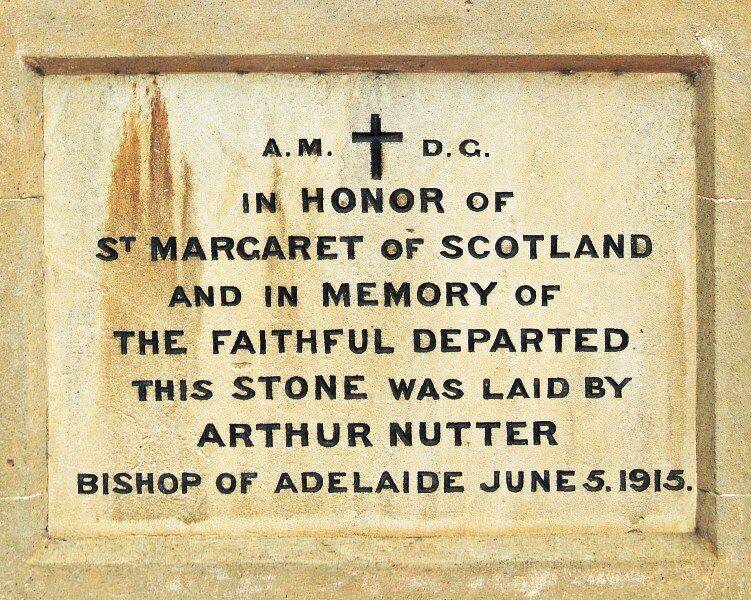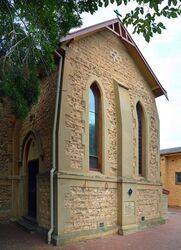
Saint Margaret of Scotland Foundation StonePrint Page 
The foundation stone of the chancel was laid in honour of Saint Margaret of Scotland and in memory of the faithful departed. Saint Margaret is the patron saint of Scotland and her feast day is celebrated on November 16.
St. Margaret of Scotland, or Margaret of Wessex, was an English princess born in Hungary to Princess Agatha of Hungary and English Prince Edward the Exile around 1045. Her siblings, Cristina and Edgar the Atheling were also born in Hungary around this time.
Margaret and her family returned to England when she was 10-years-old and her father was called back as a potential successor to the throne. However, Edward died immediately after the family arrived, but Margaret and Edgar continued to reside at the English court.
Margaret's family fled from William the Conqueror after his victory at the Battle of Hastings in 1066. Her widowed mother set out to take her children north to Northumbria. Malcolm Canmore III, the King of Scotland, welcomed Margaret and her family and put them under his protection. Margaret and Malcolm became married in 1070 at the castle of Dunfermline.
Together, they had eight children, six sons and two daughters. Margaret's kind-nature and good heart was a strong influence on Malcolm's reign. She softened his temper and helped him become a virtuous King of Scotland. Together they prayed, fed the hungry, and offered a powerful example of living faith in action. Margaret was placed in charge of all domestic affairs and was often consulted with state matters, as well. She promoted the arts and education in Scotland. She encouraged Church synods and was involved in efforts to correct the religious abuses involving Bishops, priests and laypeople. Her impact in Scotland led her to being referred to as, "The Pearl of Scotland."
She constantly worked to aid the poor Scotland. She encouraged people to live a devout life, grow in prayer, and grow in holiness. She helped to build churches, including the Abbey of Dunfermline, where a relic of the true Cross is kept. She was well-known for her deep life of prayer and piety. She set aside specific times for prayer and to read Scripture. She didn't eat often and slept very little so she would have more time for her devotions.
In 1093, Malcolm and their oldest son were killed during the Battle of Alnwick. Already ill and worn from a life full of austerity and fasting, Margaret passed away four days after her husband, on November 16, 1093. Her body was buried before the high altar at Dunfermline.
In 1250, Pope Innocent IV canonized Margaret as a Saint, acknowlegeing her life of holiness and extraordinary virtue. She was honored for her work for reform of the Church and her personal holiness.
In 1259, Margaret's and Malcolm's bodies were transferred to a chapel in the eastern apse of Dunfermline Abbey. In 1560, Mary Queen of Scots came into possession of Margaret's head. It was kept as a relic. She insisted that it, and Margaret's prayers from heaven, helped assist her in childbirth. Her head later ended up with the Jesuits at the Scots' College, Douai, France, but was lost during the French Revolution.
Location
| Address: | Port & Woodville Roads, St Margaret`s Anglican Church, Woodville, 5011 |
|---|---|
| State: | SA |
| Area: | Foreign |
| GPS Coordinates: | Lat: -34.880377 Long: 138.535281 Note: GPS Coordinates are approximate. |
Details
| Monument Type: | Plaque |
|---|---|
| Monument Theme: | People |
| Sub-Theme: | Religion |
Dedication
| Actual Monument Dedication Date: | Saturday 5th June, 1915 |
|---|
A. M. D. G.
In honor of St Margaret of Scotland and in memory of the faithful departed
This stone was laid by Arthur Nutter Bishop of Adelaide
June 5, 1915.





 Foundation Stone Laying 1915
Foundation Stone Laying 1915
